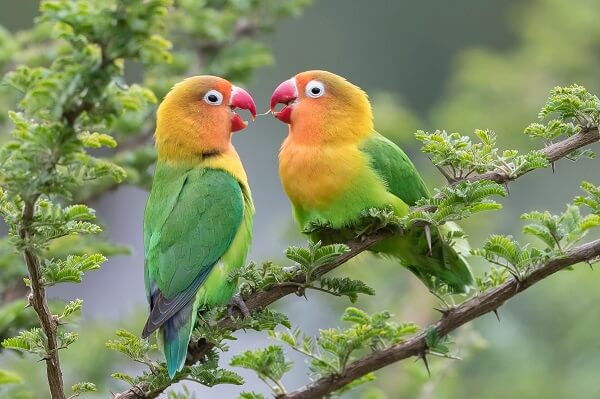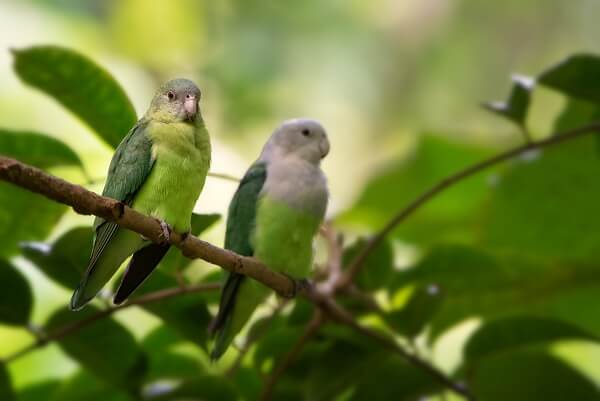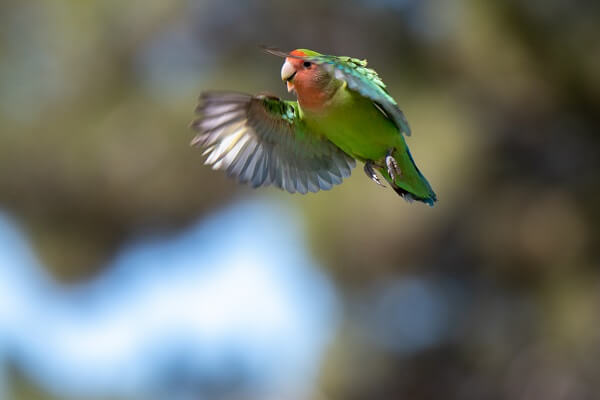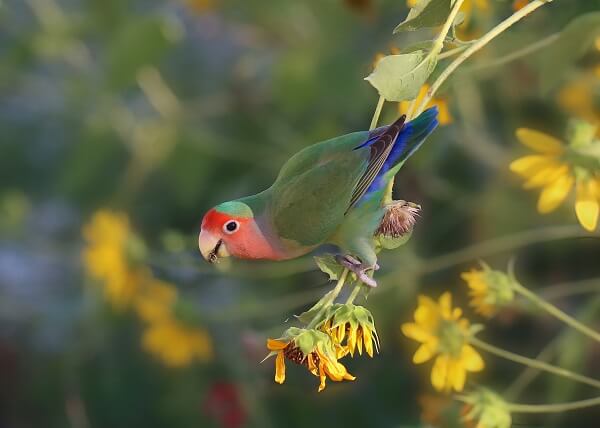
Lovebirds (genus Agapornis) are chunky, short-tailed birds that are native to the forests and savannas of sub-Saharan Africa and Madagascar. There are nine species of lovebirds in total. Eight species of lovebirds are found across Africa, where their distribution sometimes overlaps. One – the grey-headed lovebird (Agapornis canus), or Madagascar lovebird – is endemic to Madagascar and is the only lovebird found on the island. Lovebirds are small parrots that are mostly green in color, although some have orange, yellow, grey, black, or red colors on their heads and neck. They have relatively large, sharp beaks and a prominent ring around their eyes. The largest species is the rosy-faced lovebird (A. roseicollis), which is found across Africa, from Angola to South Africa. These birds are social and live in flocks, and sometimes they will forage together. They are herbivores, and their diet consists of seeds, fruits, and berries. Some species are generalists and will eat whatever they can find, whereas others are specialists and feast only on particular plant material. They make their homes in holes in trees, rocks, or in shrubs. Some species nest together, while others pair off and build their nests away from the flock. Lovebirds are monogamous and will bond for their entire life span. The male will often court the female by feeding her small pieces of food, although some species are known to dance and sing to win the female over. During the breeding season, the female will lay 4 to 6 eggs, which incubate for approximately 20 days. After hatching, both the parents care for the chick before it fledges at around one month of age. Lanner falcons (Falco biarmicus) are known to prey on lovebirds, who will often seek refuge in thorny bushes to avoid capture. Other threats to lovebirds include habitat destruction and capture for the pet trade. Lovebirds make popular pets due to their small size, beautiful bright colors, and high energy. They are also known to be extremely affectionate, especially if they are kept alone and bond with the human. Despite the threats of habit destruction, six species of lovebirds face little threat and are listed as least concern. However, the black-cheeked lovebird is listed as vulnerable, and the Nyasa and Fischer’s lovebird is listed as near threatened. These beautiful little parrots have a number of biological adaptations that make them extremely well adapted for the environment in which they live. Lovebirds are one of the smallest species of true parrots and are extremely agile flyers, performing acrobatics in the air. Let’s investigate further. Lovebirds are famous for their flying skills, with the ability to maneuver quickly in dense areas. To understand what makes them such swift and agile flyers, researchers used high-speed cameras to film the birds. The captured footage led the researchers to discover that these birds can move their heads extremely quickly. In fact, lovebirds can turn their heads up to 270 degrees at a speed of 2700 degrees per second, which is as fast as insects! This swift movement is one of the fastest animal movements recorded! This ability to move their heads at super-fast speeds helps them to see in all directions while in the air. This means that these birds have more time to see and react to the environment around them, avoiding potential collisions and enabling them to keep a clear line of sight while twisting and turning during flight. Lovebirds have a robust, hooked bill that is characteristic of parrot species. From afar, it looks very similar to the bill of hawks and owls, but the upper and lower mandibles have a sharper, more uniform curve. The hooked upper mandible for the lovebird’s beak fits into the lower mandible like a piece of a jigsaw. The broad, powerful bills of the lovebird have evolved as a result of their diet, enabling them to crack seeds and tear into fruits. The beak is made of keratin, so it can grow continuously. To keep their beak at a perfect length and to ensure that it is sharp, the birds will nibble on hard objects, like branches. Monogamy is a fascinating behavior that is common in some parts of the animal kingdom. It likely evolved when the offspring had a much better chance of surviving if both parents were present. Lovebirds are known for being monogamous. The birds form extremely strong bonds and can often be observed feeding and pruning each other. Lovebirds will form mating pairs for life, which can mean these birds are bonded for up to 15 years! About 90% of bird species are monogamous, but unlike lovebirds, this may just be for one or more breeding seasons. Lovebirds will form mating pairs for life. There are several advantages to being monogamous. The first is that the birds can share parental responsibilities. The female will sit on her nest once she has laid the eggs and incubate the eggs for approximately three weeks. During this time, the male will bring her food. Once the chicks have hatched, the female will stay with her brood, and the male will gather food. This means that one parent is always able to protect the chicks from potential predators. A second advantage is that once the birds are bonded, they won’t have to waste energy trying to find a mate. If the bond between the birds is right, then there is no advantage to wasting energy searching for a new mate at the start of the next breeding season.
Kingdom
Animalia
Phylum
Chordata
Class
Aves
Order
Psittaciformes
Family
Psittacidae
Genus
Agapornis
Species
Nine
Niche
Herbivorous
Length
4 – 6 in (10 – 16cm)
Weight
0.125 lbs ( 56.7g)
Lifespan
15 to 25 years
Social Structure
Flock
Conservation Status
One vulnerable, two near threatened, the rest are listed as least concern
Preferred Habitat
Various
Average Clutch Size
4 – 6 eggs
Main Food
Berries, nuts, seeds
Main Threats
Habitat destruction and the pet trade
The Basics

Interesting Insights from Lovebirds!
Head Movements During Flying

Beak Adaptations

Monogamy
